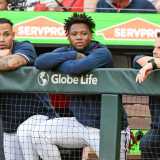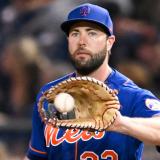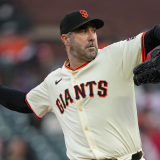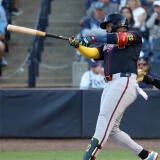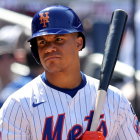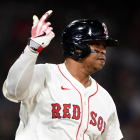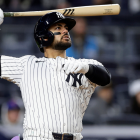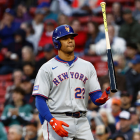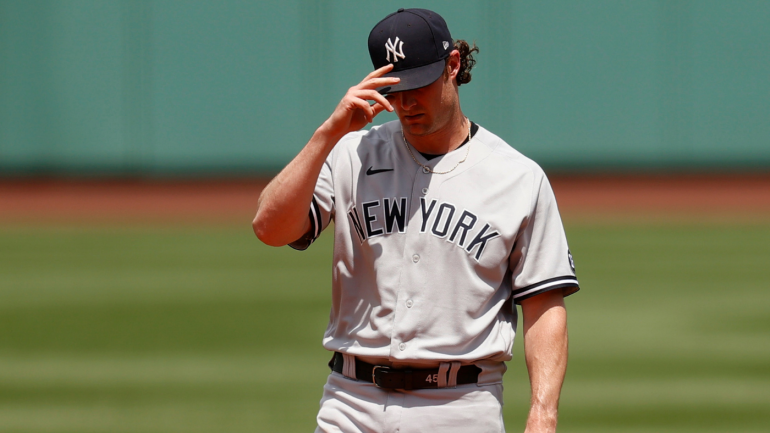
Three months into the 2021 season, the New York Yankees are 42-41 with a minus-11 run differential. They've lost seven of their last nine games to fall 5 1/2 games behind the second wild card spot. Current records indicate it will take 95 wins to qualify for the postseason in the American League, so New York needs to go 53-26 the rest of the way. That's a 109-win pace. Ouch.
Two weeks ago we looked at Gary Sánchez's resurgence, Zack Britton's return, and Deivi García's struggles in Triple-A. Now here are three new notable Yankees trends.
Cole struggling since foreign substance crackdown
For the first two months of the season, the Yankees knew no matter how bad things got offensively or on the bases or on the scoreboard, they could give the ball to Gerrit Cole every five days, and things would be OK. Cole was masterful in April and May, more than earning his All-Star Game selection. His 3.6 WAR is still second among AL pitchers behind Kyle Gibson (4.4 WAR).
The last few weeks have been a slog for Cole, however. The Mets tagged him for four runs on six hits and three walks in 3 1/3 innings Sunday. It was Cole's shortest start since September 2016, when he was still with the Pirates. Look at Cole's June and July:
| GS | IP | ERA | FIP | WHIP | K% | BB% | HR/9 | |
|---|---|---|---|---|---|---|---|---|
April and May | 11 | 70 2/3 | 1.78 | 1.76 | 0.83 | 36.9% | 3.4% | 0.64 |
June and July | 6 | 34 1/3 | 5.24 | 5.69 | 1.22 | 26.2% | 7.6% | 2.62 |
2021 total | 17 | 105 | 2.91 | 3.04 | 0.96 | 33.1% | 4.9% | 1.29 |
The overall numbers are what you'd expect from Cole. Getting there has been bumpy, and some of that is home run regression. From 2018-20, Cole allowed 1.15 homers per nine innings and homers on 14.2 percent of fly balls. In April and May, it was 0.64 HR/9 and 8.3 HR/FB%. After June, his 2021 homer numbers (1.29 HR/9 and 14.9 HR/FB%) look almost exactly like 2018-20.
Beyond the home run rate regression, the elephant in the room is MLB's crackdown on foreign substances. Cole is a known sticky-stuff user (he was named in a lawsuit that included text messages) and, fair or not, he's become the face of MLB's crackdown. He is one of the game's best pitchers, he plays for the game's highest-profile team, and he has a record contract. It is what it is.
"I don't quite know how to answer that, to be honest," Cole said last month when asked whether he uses foreign substances. "There are customs and practices that have been passed down from older players to younger players, from past generation players to this generation of players. I think there are some things that are certainly out of bounds in that regard, and I've stood pretty firm in terms of that."
Cole's spin rates have been down since the last few weeks. They first dipped when MLB let everyone know the crackdown was coming early in June, and they dipped again when the crackdown took effect later in the month. Here are Cole's start by start spin rates this season (all pitch types together):
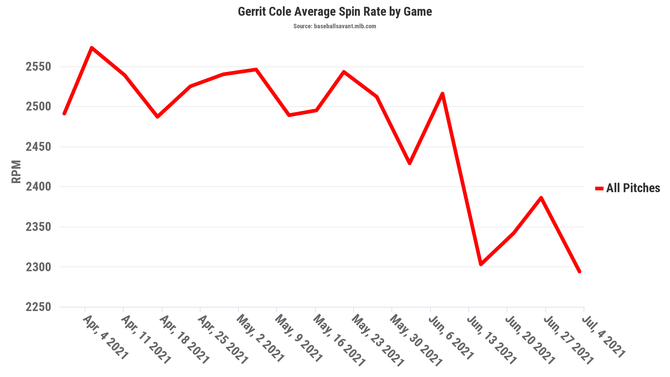
Cole's average spin rate Sunday was his lowest since his final start with Pittsburgh in 2017. A spin rate decline in the 50-75 rpm range is nothing, really. That falls under normal start-to-start fluctuation. A spin rate decline of 200-plus rpm indicates sticky stuff, however, and Cole's spin rate decline falls comfortably into that range. Clearly, the crackdown is impacting him.
How much the crackdown is impacting him is unclear and difficult to unravel from normal home run rate regression and the general uptick in offense around the league. Offense always jumps when the weather warms up in June and July, and determining which factors account for how much of a change in performance is damn near impossible. There's no one reason offense is up.
For Cole, the spin rate decline is most notable on his four-seam fastball, which he uses to get swings and misses up in the zone. At his best, he dominates hitters with 98-100 mph heaters at eye level. Here are the numbers on his four-seam fastball:
| Avg. velo | Avg. spin | Whiff rate | Foul rate | Opp. AVG | Opp. SLG | Avg. exit velo | |
|---|---|---|---|---|---|---|---|
April and May | 97.2 mph | 2,562 rpm | 30.6% | 45.9% | .238 | .366 | 92.0 mph |
June and July | 97.9 mph | 2,390 rpm | 19.5% | 49.6% | .192 | .423 | 91.1 mph |
2021 MLB average | 93.8 mph | 2,255 rpm | 22.1% | 44.4% | .260 | .459 | 90.1 mph |
Cole's fastball spin rate is down substantially, his whiff rate (i.e. misses per swing) is down substantially, and his foul rate is up as well. Opponents have had a lower batting average against Cole's fastball since June 1, though the slugging percentage is up quite a bit. The whiff and foul rates are telling. With reduced spin, hitters are having an easier time getting the bat on Cole's heater.
The best example of this came in the fourth inning Sunday. Billy McKinney fouled away a 99-mph fastball and then a 100-mph fastball, both with two strikes, before drawing a walk to load the bases with no outs. In the past, hitters would swing through these pitches and get Cole the strikeout. Instead, McKinney was able to fight them off.
There is also a command component to foreign substances that can't be quantified. Anecdotally, Cole has left more pitches over the middle of the plate the last few weeks, and he's paying with home runs and harder contact in general. Cole's walk rate is up since the crackdown, though walks are a control stat. That's strike-throwing. Command is quality strikes on the corners, at the knees, etc.
Cole's performance has suffered since the foreign-substance crackdown was announced to the world and it is naive to think there is no correlation. I also don't think we should assume the 2021 June and July version of anyone is their true self, the same way we shouldn't assume road numbers away from Coors Field tells us a Rockies player's true talent level.
MLB dropped the crackdown on pitchers at midseason and they're going to need time to adjust. The adjustment might not happen until the offseason in some cases. And, to be clear, "adjustment" in this case could mean finding a different way to cheat. Players haven't earned the benefit of the doubt here. As long as there are sports, players will look for that extra advantage.
Cole had a poor June and a bad start to July, and the foreign-substance crackdown is playing a role in it, likely a substantial role. The 2021 Yankees need Cole to right the ship and soon, because they're already facing an uphill battle to get to the postseason. The 2022-29 Yankees need Cole to figure it out too, because he's still owned a lot of money the next seven years.
Chapman's struggles
Cole is not the only Yankee (or the only pitcher in the league, really) struggling since the foreign-substance crackdown. Closer (and fellow All-Star) Aroldis Chapman is in the middle of the worst stretch as a big leaguer. He's allowed 15 runs in his last nine games and 5 2/3 innings. From 2012-19, Chapman averaged 15.1 runs allowed per season.
Chapman has blown leads in each of his last three appearances, including a four-run lead last Wednesday and a one-run lead on Sunday. His last eight batters have gone walk, ground out, walk, walk, game-tying grand slam, game-tying solo homer, hit by pitch, walk. Opponents have hit .483/.615/.931 (!) against Chapman in his last nine games. That is hard to believe.
Here are Chapman's two most recent meltdowns:
"The big problem is the control of my fastball," Chapman told reporters, including Greg Joyce of the New York Post, after blowing the four-run lead against the Angels last week. "[I've] got to find myself again with that pitch and come back and return to be Chapman that started the season."
Despite the recent poor performance, manager Aaron Boone said he was "confident" giving the ball to Chapman with a one-run lead Sunday. After Chapman blew the game, Boone said the Yankees will "continue to talk through that" when asked whether Chapman is still his closer (video link). At this point, a change must be made.
Unlike Cole, Chapman's spin rates have held steady since the foreign-substance crackdown. He's always been an exceptionally high spin rate pitcher and his spin rates remain exceptionally high. His control has complete disappeared, however. We're not talking about command and hitting the corners. I'm talking about basic strike-throwing. Chapman can't find the zone at all.
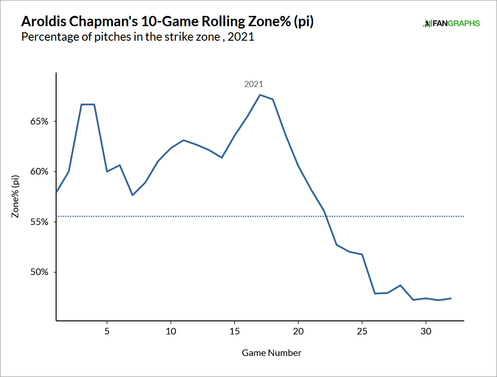
Of course, Chapman owns a career 11.7 percent walk rate, so bouts of wildness (sometimes extreme wildness) are not uncommon. Getting hit this hard through? That's unusual. Chapman has allowed five home runs already this year, two short of his career high and more than he allowed every year from 2014-20 (2020 was a shortened season, obviously).
The Chapman conundrum is more difficult to unpack than Cole's struggles. Cole has shown a substantial decline in spin rate as well as the things spin rate helps (i.e. swings and misses). Chapman's spin rates have held firm. He just can't locate, and when he does get the ball in the zone, it's getting hammered. Chapman walking himself into jams is nothing new. The hard contact is.
I suppose the good news is Chapman appears healthy. He's been dealing with a minor fingernail issue the last few weeks, but his velocity is good, so it doesn't look like he's pitching through an arm issue. The decline in control and increase in hard contact would be a major red flag if his velocity was down too. Without that, it's a bit of a head-scratcher.
The Yankees have no choice but to remove Chapman from the closer's role and let him work through his issues in lower-leverage situations. They have a lot of ground to make up in the postseason race and they can't let him continue to squander leads. Chad Green and Jonathan Loaisiga (and Zack Britton, once healthy) are more than capable of closing games in the interim.
Earlier this season Chapman was as good as we've ever seen him. He allowed two runs (one earned) with 43 strikeouts in his first 23 innings, and held opponents to a .097/.214/.194 opponent's batting line. Chapman was automatic, and that guy is so far gone now. This is the worst stretch of his career by a wide margin, and that it happened after the sticky-stuff crackdown raises questions.
The lack of lefty production
It is no secret the Yankees have been mired in a season-long offensive malaise. They're averaging only 4.11 runs per game, the seventh fewest in baseball going into Monday's action, and only the Astros (84) have grounded into more double plays (82). Houston has scored 133 more runs than the Yankees, so their double play issues can be forgiven. New York's? Not so much.
The history of the Yankees is littered with high-end left-handed hitters. Babe Ruth, Lou Gehrig, Roger Maris, Reggie Jackson, Paul O'Neill, Robinson Canó, on and on it goes. And yet this year, the Yankees rank among the worst teams in lefty hitting production, mostly because they have so few lefty hitters. Their left-handed hitting ranks going into Monday:
- Plate appearances: 658 (29th, the Blue Jays have 656 and the Cardinals are the next lowest at 919)
- Batting average: .190 (30th, the Cardinals are next lowest at .210)
- On-base percentage: .292 (28th, the Marlins are at .281 and the Cardinals are at .290)
- Slugging percentage: .219 (29th, the Cardinals are at .318)
- Home runs: 16 (28th, the Blue Jays have 13 and the Cardinals have 15)
The Yankees play in Yankee Stadium with its short right field porch, and somehow their left-handed hitters are slugging .219 this season. It can't entirely be blamed on injuries either. Aaron Hicks, a switch-hitter, is the team's best lefty threat and he's been out with a wrist injury since mid-May. All the other lefties are healthy. They're just not hitting.
To really drive home how little production the Yankees have received from their left-handed hitters this season, here is the home run leaderboard among lefties at Yankee Stadium this year:
- Rougned Odor, Yankees: 4
- Austin Meadows, Rays: 3
- Shohei Ohtani, Angels: 3
- Brett Gardner, Yankees: 2
- Yordan Alvarez, Astros: 2
- Tony Kemp, Athletics: 2
- Matt Olson, Athletics: 2
- Ryan O'Hearn, Royals: 2
- Jared Walsh, Angels: 2
- Joey Wendle, Rays: 2
- 11 tied with one (including Jay Bruce and Mike Ford with the Yankees)
To put it another way, Yankees left-handed hitters have hit eight home runs in 45 games at Yankee Stadium this year. Rays lefties have six in six games. Angels lefties have five in three games. Athletics lefties have four in three games. The Yankees have eight in 45 games. Eight in 45 games! That seems impossible, and yet it is very much true.
The Yankees have hit so few left-handed home runs at Yankee Stadium this year that you can fit them all in one four-and-a-half minute video. Enjoy:
It is sort is sort of amazing -- and a gross miscalculation by the front office -- the Yankees have such a righty-heavy lineup despite playing home games in lefty-friendly Yankee Stadium. Seemingly every series they play a team better suited for Yankee Stadium than the Yankees. That was certainly true when the Angels and Mets were in town last week.
When the time comes for the Yankees to remake their offense this offseason (all available evidence suggests they need to remake the offense), they must emphasize left-handed hitters. You don't want all lefties, obviously. Too much is a bad thing. But you need some, especially in Yankee Stadium. New York's lineup is woefully imbalanced right now.
![[object Object] Logo](https://sportshub.cbsistatic.com/i/2020/04/22/e9ceb731-8b3f-4c60-98fe-090ab66a2997/screen-shot-2020-04-22-at-11-04-56-am.png)







